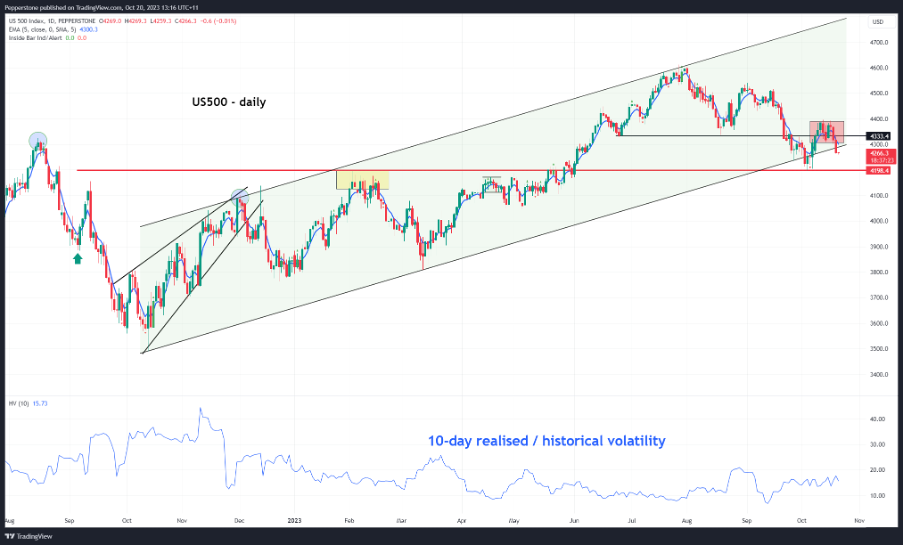Trader Thoughts – its when realised volatility rises that we should worry

The VIX index at 21.4% equates to implied daily moves in the US500 of 1.34%, and 3% over the week.
The market's key concern, and a critical mover of risk, remain concerns surrounding an escalation in the countries involved in the geopolitical tensions, with the US unable to contain the conflict. It is becoming one largely correlated trade – new headlines emerge, Brent crude, and to a lesser extent (currently) EU Nat gas rallies, and we subsequently see buyers in the CHF and gold. Equity vol also rises, and funds rotate into defensive areas of the market and offset risk through energy names.
It would be when we see S&P500 realised volatility moving higher that should see things move even more aggressively. This is where we see a lot of the hedge funds that target a specific level of volatility start to reduce equity holdings, while CTA’s (systematic trend following funds) would also reduce exposures. With reduced buyers in the market and higher vols, this is the time when short sellers will see their ideal conditions to deploy strategies.
As we see S&P500 10-day realised vol remains subdued, but any lift could have big implications.

The other aspect of the market cross-current is the ever-higher yields in 10- and 30-year US Treasuries. This has in part been driven by a rise in US real rates (bonds adjusted for expected inflation over that period). But also, ‘term premium’, or the additional compensation bond investors require to hold longer-dated debt rather than simply holding and rolling over 2-year Treasuries upon maturity. A resilient US economy is partly behind that, and so is the Fed’s current commitment to higher for longer.
The deteriorating US fiscal position is likely playing a role in higher long-end yields too and the notion of increasing supply from the US Treasury department, a factor even Jay Powell mentioned last night was “unsustainable”. As we head to the next US Treasury Quarterly Refunding date in November, the fact President Biden is requesting a $100b aid package for Israel and Ukraine to a leaderless House will only exacerbate concerns around Increasing bond supply and the potential demand from private investors.
While fixed-income investors see the conviction in trading Treasury curve steepeners, many others ask, “Will something in the system break”? Well, we look for the signal in the price action in credit, volatility, and bank equity. For now, what may be more prevalent, in the shorter term, would be a sharp rise in energy that moves concurrently with even higher long-end yields – that would be a toxic mix for risk.
As we close out the week, traders will be paying attention to the tape today as we roll into European and US trade – Will traders de-risk going into the weekend and put further safe-haven bets on, seeing the potential for another gapping risk in Monday's cash and futures open?
Related articles
The material provided here has not been prepared in accordance with legal requirements designed to promote the independence of investment research and as such is considered to be a marketing communication. Whilst it is not subject to any prohibition on dealing ahead of the dissemination of investment research we will not seek to take any advantage before providing it to our clients.
Pepperstone doesn’t represent that the material provided here is accurate, current or complete, and therefore shouldn’t be relied upon as such. The information, whether from a third party or not, isn’t to be considered as a recommendation; or an offer to buy or sell; or the solicitation of an offer to buy or sell any security, financial product or instrument; or to participate in any particular trading strategy. It does not take into account readers’ financial situation or investment objectives. We advise any readers of this content to seek their own advice. Without the approval of Pepperstone, reproduction or redistribution of this information isn’t permitted.

